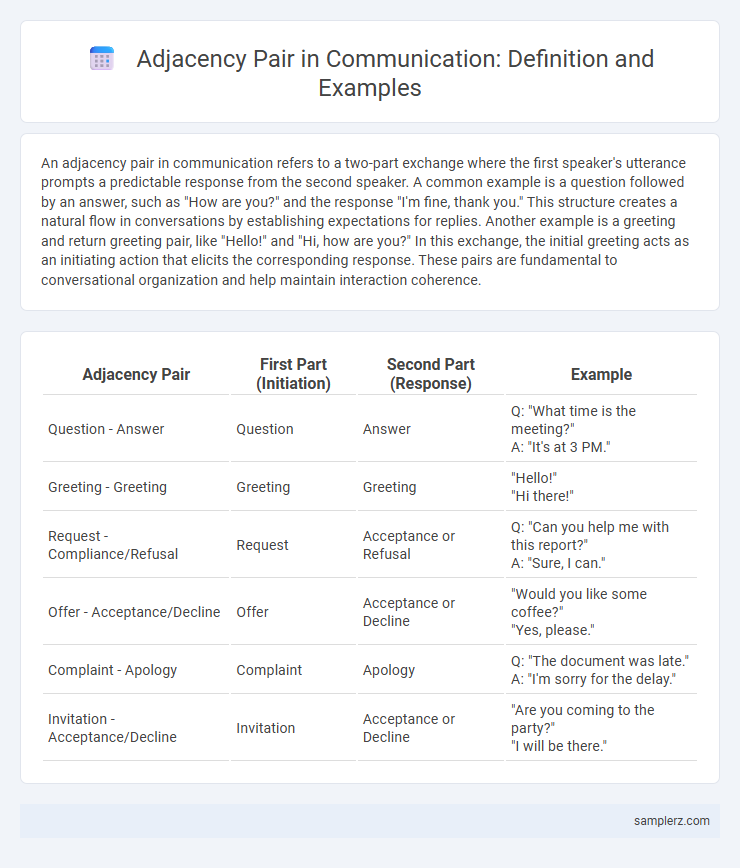An adjacency pair in communication refers to a two-part exchange where the first speaker's utterance prompts a predictable response from the second speaker. A common example is a question followed by an answer, such as "How are you?" and the response "I'm fine, thank you." This structure creates a natural flow in conversations by establishing expectations for replies. Another example is a greeting and return greeting pair, like "Hello!" and "Hi, how are you?" In this exchange, the initial greeting acts as an initiating action that elicits the corresponding response. These pairs are fundamental to conversational organization and help maintain interaction coherence.
Table of Comparison
| Adjacency Pair | First Part (Initiation) | Second Part (Response) | Example |
|---|---|---|---|
| Question - Answer | Question | Answer | Q: "What time is the meeting?" A: "It's at 3 PM." |
| Greeting - Greeting | Greeting | Greeting | "Hello!" "Hi there!" |
| Request - Compliance/Refusal | Request | Acceptance or Refusal | Q: "Can you help me with this report?" A: "Sure, I can." |
| Offer - Acceptance/Decline | Offer | Acceptance or Decline | "Would you like some coffee?" "Yes, please." |
| Complaint - Apology | Complaint | Apology | Q: "The document was late." A: "I'm sorry for the delay." |
| Invitation - Acceptance/Decline | Invitation | Acceptance or Decline | "Are you coming to the party?" "I will be there." |
Understanding Adjacency Pairs in Communication
Adjacency pairs in communication illustrate the predictable exchange of utterances, such as question-answer or greeting-greeting sequences, essential for coherent interaction. For example, a customer asks, "What time do you close?" and the clerk replies, "We close at 8 PM," demonstrating a clear inquiry-response structure. These pairs facilitate mutual understanding by setting expectations for appropriate replies, enhancing conversational flow and reducing misunderstandings.
Classic Greetings and Responses: A Fundamental Adjacency Pair
Classic greetings and responses exemplify a fundamental adjacency pair in communication, where an initial greeting such as "Hello" is met with an appropriate response like "Hi" or "Good morning." This exchange establishes mutual acknowledgment and sets the tone for further interaction. Adjacency pairs like greetings and responses are essential for maintaining conversational coherence and social rapport.
Offering and Accepting/Declining: Common Conversational Moves
Offering and accepting or declining form a crucial adjacency pair in communication, exemplified when one speaker offers assistance or items, and the other responds accordingly. Typical exchanges include offers like "Would you like some coffee?" followed by acceptance "Yes, please," or polite declination "No, thank you." These conversational moves reflect social etiquette and cooperative interaction in daily communication scenarios.
Question and Answer: The Core Exchange Example
An adjacency pair in communication exemplifies the Question and Answer core exchange, where one speaker poses a question and the other responds appropriately, establishing a predictable conversational structure. For example, a customer service interaction often involves the customer asking, "What are your opening hours?" followed by the representative answering with specific times, such as "We are open from 9 AM to 6 PM, Monday through Friday." This structure ensures clarity and understanding, facilitating effective information exchange in various communication settings.
Invitation and Acceptance/Refusal Pairings
An adjacency pair in communication exemplifies the structured exchange between a speaker and a respondent, such as an invitation followed by an acceptance or refusal. For instance, one person might say, "Would you like to join my team meeting tomorrow?" and the other may respond with, "Yes, I'd be happy to join," demonstrating acceptance, or "Sorry, I'm unavailable," illustrating refusal. This pattern reinforces social norms and expectations in conversational turn-taking and ensures clarity in interpersonal interactions.
Compliments and Expected Responses
In communication, an adjacency pair involving compliments typically features a positive evaluation followed by an expected response such as acceptance or gratitude. For example, when one person says, "You did a great job on the presentation," the expected response might be, "Thank you, I appreciate that." This exchange maintains social harmony and reinforces positive interpersonal relationships.
Apologies and Acknowledgements in Dialogue
Apologies and acknowledgements form crucial adjacency pairs in communication, where one speaker issues an apology and the other responds with an acknowledgement to maintain social harmony. For example, when a person says, "Sorry for the delay," the typical response could be, "That's okay, no problem," effectively closing the exchange. This interaction structure supports smooth conversational flow and reinforces mutual understanding in dialogue.
Requests and Granting/Rejecting Responses
Requests often initiate adjacency pairs in communication, where a speaker asks for permission or assistance, such as "Can you send me the report?" The recipient's response either grants the request, "Sure, I'll send it by noon," or rejects it, "I'm sorry, I can't meet that deadline." These adjacency pairs are essential for structuring effective exchanges and managing interpersonal interactions in workplace or everyday communication.
Farewells and Closing Responses
Farewells and closing responses in conversations exemplify adjacency pairs, where a speaker's goodbye is predictably followed by a corresponding farewell, such as "Goodbye" and "See you later." These pairs establish social norms and signal the end of interaction, ensuring mutual understanding. The consistent use of adjacency pairs in communication enhances conversational coherence and politeness strategies.
The Role of Adjacency Pairs in Smooth Communication
Adjacency pairs, such as question-answer or greeting-greeting exchanges, play a crucial role in ensuring smooth communication by providing predictable conversational structures. These paired utterances help interlocutors interpret responses accurately and maintain the flow of dialogue. Effective use of adjacency pairs reduces misunderstandings and enhances clarity in interpersonal and professional interactions.

example of adjacency pair in exchange Infographic
 samplerz.com
samplerz.com